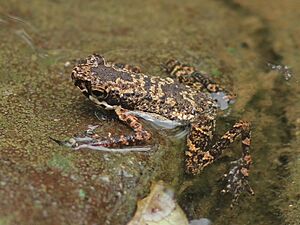Ansonia mcgregori facts for kids
Quick facts for kids Ansonia mcgregori |
|
|---|---|
 |
|
| Conservation status | |
| Scientific classification | |
| Synonyms | |
|
The Ansonia mcgregori is a type of toad that belongs to the Bufonidae family. It is found only in the central and western parts of Mindanao, which is an island in the Philippines. This toad is also known as McGregor's toad, McGregori's river toad, or McGregor's stream toad. Its scientific name, mcgregori, honors Richard Crittenden McGregor, an Australian bird expert who first collected this specific toad.
What Does McGregor's Toad Look Like?
Adult male McGregor's toads are about 32–39 mm (1.3–1.5 in) long. Female toads are a bit bigger, measuring around 43–50 mm (1.7–2.0 in) from snout to vent. You can't see their eardrum, called a tympanum.
Their fingertips are rounded and have small discs. These discs are not wider than the rest of their fingers. Their toes are almost completely webbed, which helps them in water. The back legs of these toads have special crossbar patterns. Male toads also have a vocal sac under their chin, which they use to make sounds.
Where Do These Toads Live and How Are They Protected?
Ansonia mcgregori toads live on land near cool mountain streams and rivers. They prefer forests that are not disturbed, found at heights of 300–1,700 m (980–5,580 ft) above sea level. You might find them on mossy rocks, in rock cracks, or among fallen leaves near streams.
While they mostly live in quiet places, some have been seen in forests that have been partly changed by humans. They can also be found in farms or even inside caves near farmland. These toads lay their eggs and breed in streams.
This type of toad is common where its habitat is suitable. However, its home is shrinking because of human activities. These include small farms, large palm oil plantations, and people collecting wood for charcoal. Growing towns and cities also take away their living space.
Pollution from farms, soil washing away, and waste from mines can also harm the streams where they live. Luckily, Ansonia mcgregori is found in several protected areas, which helps keep them safe.


